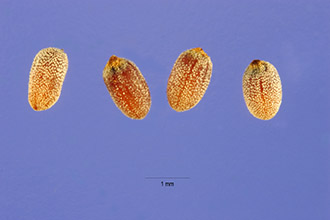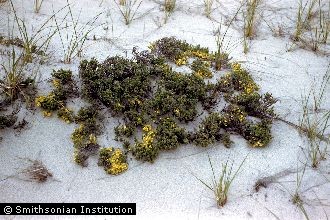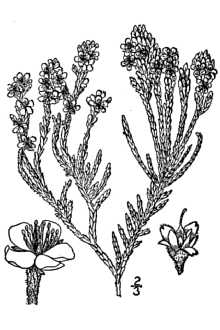Woolly Beachheather
Scientific Name: Hudsonia tomentosa Nutt.

| General Information | |
|---|---|
| Usda Symbol | HUTO |
| Group | Dicot |
| Life Cycle | Perennial |
| Growth Habits | ShrubSubshrub, |
| Native Locations | HUTO |
Plant Guide
Use soil moisture sensors to measure the soil moisture of Woolly Beachheather.
Fact Sheet
Alternate Names
sand heather, woolly hudsonia, false heather, woolly beach heather
Uses
Beach heather is used in the restoration of sand dunes and coastal native plant communities. It can also be used for developing low maintenance, salt tolerant landscapes near the shoreline.
Status
Beach heather is listed as either threatened or endangered in several states, Please consult the PLANTS Web site and your State Department of Natural Resources for this plant’s current status (e, Use soil moisture sensors to measure the soil moisture of Woolly Beachheather.,g, threatened or endangered species, state noxious status, and wetland indicator values),
Description and Adaptation
Adaptation
Adaptation
Beach heather is a low growing native shrub usually 3-8 inches tall and finely branched. Leaves are elongated and scale like, usually less than 0.125 inches long, and coated with soft, white, wooly hair. This plant has beautiful yellow flowers that are 5-petaled and about 0.25 inches across. Blooming occurs on average from May through July and provides nectar for pollinator species. This plant is adapted to sand dunes, sandy pine woods, pine-barrens, and sand hills clearings. Beach heather is much less tolerant of salt spray than the plants in the primary foredune (Dunegrass community) along the New Jersey coast. Beach heather does not compete effectively with Dunegrass community plants that are growing on the exposed primary foredune. Beach heather tends to grow in the backdune areas at an elevation of about 9 feet above sea level. The backdune habitat is more protected from salt spray and sand movement than the primary foredune, but it is very dry. Several of the plant species in the backdune, including beach heather, exhibit adaptations to dry conditions such as reduced leaf surface, prostrate growth, and leaf surfaces covered with hair or waxy covering to reduce water loss. Green sands are associated with beach heather growing in sand dunes in Alberta, Canada. Green sands were consistently found in the buried phyllosphere and rhizosphere of beach heather, and on the surface to varying depths under the plants. Nitrogen fixing blue-green algae were isolated from the green sands. Beach heather’s preference for an association with blue-green algae may relate to the ability of this dwarf shrub to grow on nutrient poor sand blowouts and dunes. Also, in Alberta, a preliminary study showed that beach heather was associated with ectomycorrhizal symbionts at three active dune sites. Distribution: Beach heather occurs along the Atlantic Coast from Main to North Carolina, along the Great Lakes from New York to Minnesota and along Lake Champlain. Its range extends northwestward to Alberta, Canada. For more information please consult the Plant Profile page for this species on the PLANTS Web site. Establishment and
Management
Beach heather establishment and management guidelines have not been developed at the time of this publication. However, pervious reports indicate that beach heather is short-lived and fairly difficult to grow, but can be propagated from seed and cuttings.
Pests and Potential Problems
Beach heather has not been observed to manifest any notable problems with pests. In beach habitat, beach heather is sensitive to trampling, mechanical disturbances by off-road vehicles, and over shading by woody species.
Plant Traits
Growth Requirements
| Temperature, Minimum (°F) | -13 |
|---|---|
| Adapted to Coarse Textured Soils | Yes |
| Adapted to Fine Textured Soils | No |
| Adapted to Medium Textured Soils | No |
| Anaerobic Tolerance | None |
| CaCO3 Tolerance | High |
| Cold Stratification Required | Yes |
| Drought Tolerance | High |
| Fertility Requirement | Low |
| Fire Tolerance | Medium |
| Frost Free Days, Minimum | 170 |
| Hedge Tolerance | None |
| Moisture Use | Low |
| pH, Maximum | 6.9 |
| pH, Minimum | 5.5 |
| Planting Density per Acre, Maxim | 1200 |
| Planting Density per Acre, Minim | 700 |
| Precipitation, Maximum | 55 |
| Precipitation, Minimum | 35 |
| Root Depth, Minimum (inches) | 26 |
| Salinity Tolerance | High |
| Shade Tolerance | Intolerant |
Morphology/Physiology
| Bloat | None |
|---|---|
| Toxicity | None |
| Resprout Ability | No |
| Shape and Orientation | Decumbent |
| Active Growth Period | Spring and Summer |
| C:N Ratio | High |
| Coppice Potential | No |
| Fall Conspicuous | Yes |
| Fire Resistant | Yes |
| Flower Color | Yellow |
| Flower Conspicuous | Yes |
| Foliage Color | Gray-Green |
| Foliage Porosity Summer | Dense |
| Foliage Porosity Winter | Dense |
| Fruit/Seed Color | Brown |
| Nitrogen Fixation | None |
| Low Growing Grass | No |
| Lifespan | Long |
| Leaf Retention | No |
| Known Allelopath | No |
| Height, Mature (feet) | 1.0 |
| Growth Rate | Slow |
| Growth Form | Multiple Stem |
| Fruit/Seed Conspicuous | No |
| Foliage Texture | Fine |
Reproduction
| Vegetative Spread Rate | None |
|---|---|
| Small Grain | No |
| Seedling Vigor | Low |
| Seed Spread Rate | Slow |
| Fruit/Seed Period End | Fall |
| Propagated by Tubers | No |
| Propagated by Sprigs | No |
| Propagated by Sod | No |
| Propagated by Seed | Yes |
| Propagated by Cuttings | Yes |
| Propagated by Container | Yes |
| Propagated by Bulb | No |
| Propagated by Bare Root | Yes |
| Fruit/Seed Persistence | No |
| Fruit/Seed Period Begin | Summer |
| Fruit/Seed Abundance | Low |
| Commercial Availability | Routinely Available |
| Bloom Period | Late Spring |
| Propagated by Corm | No |
Suitability/Use
| Veneer Product | No |
|---|---|
| Pulpwood Product | No |
| Protein Potential | Low |
| Post Product | No |
| Palatable Human | No |
| Palatable Graze Animal | Low |
| Palatable Browse Animal | Low |
| Nursery Stock Product | Yes |
| Naval Store Product | No |
| Lumber Product | No |
| Fodder Product | No |
| Christmas Tree Product | No |
| Berry/Nut/Seed Product | No |


